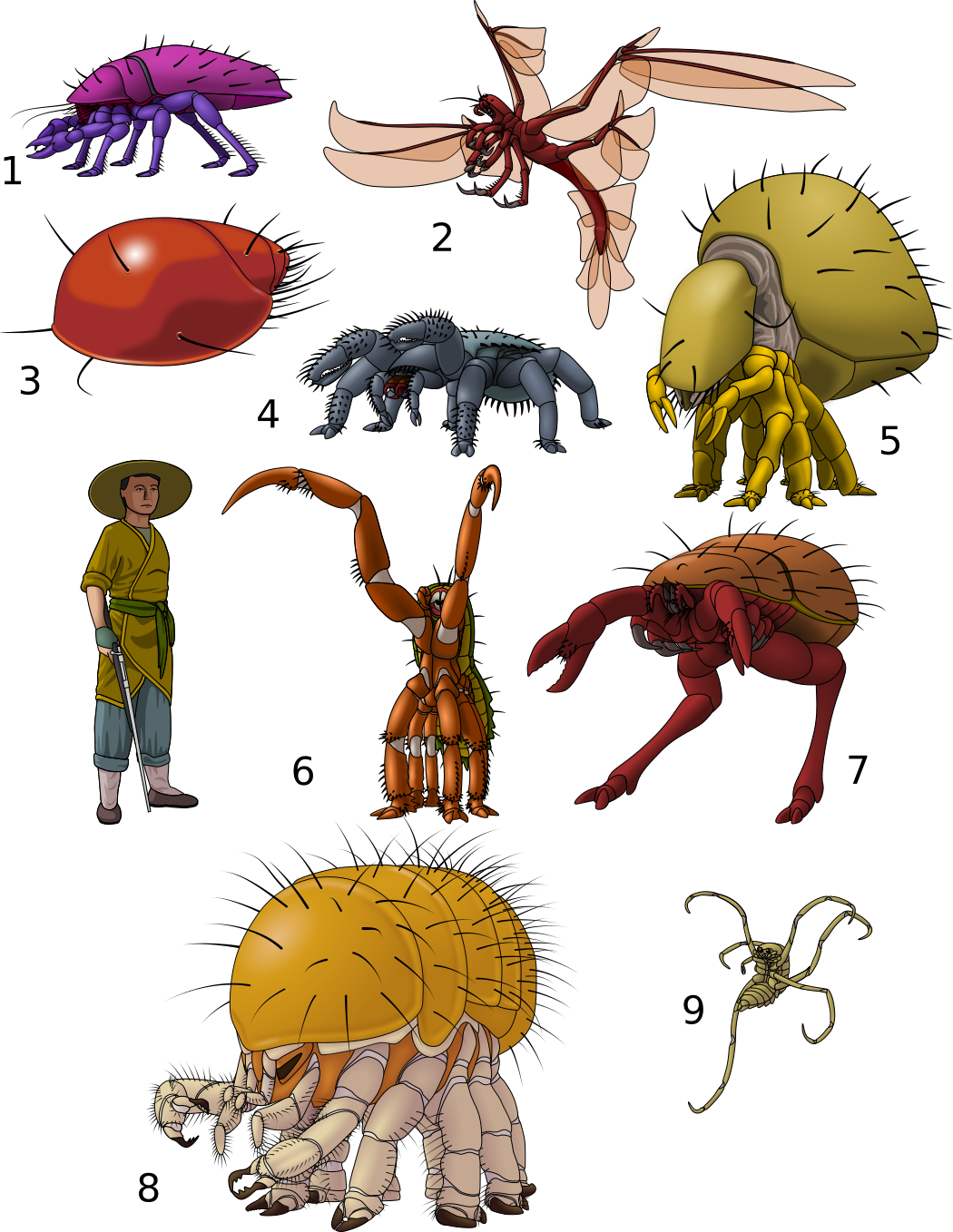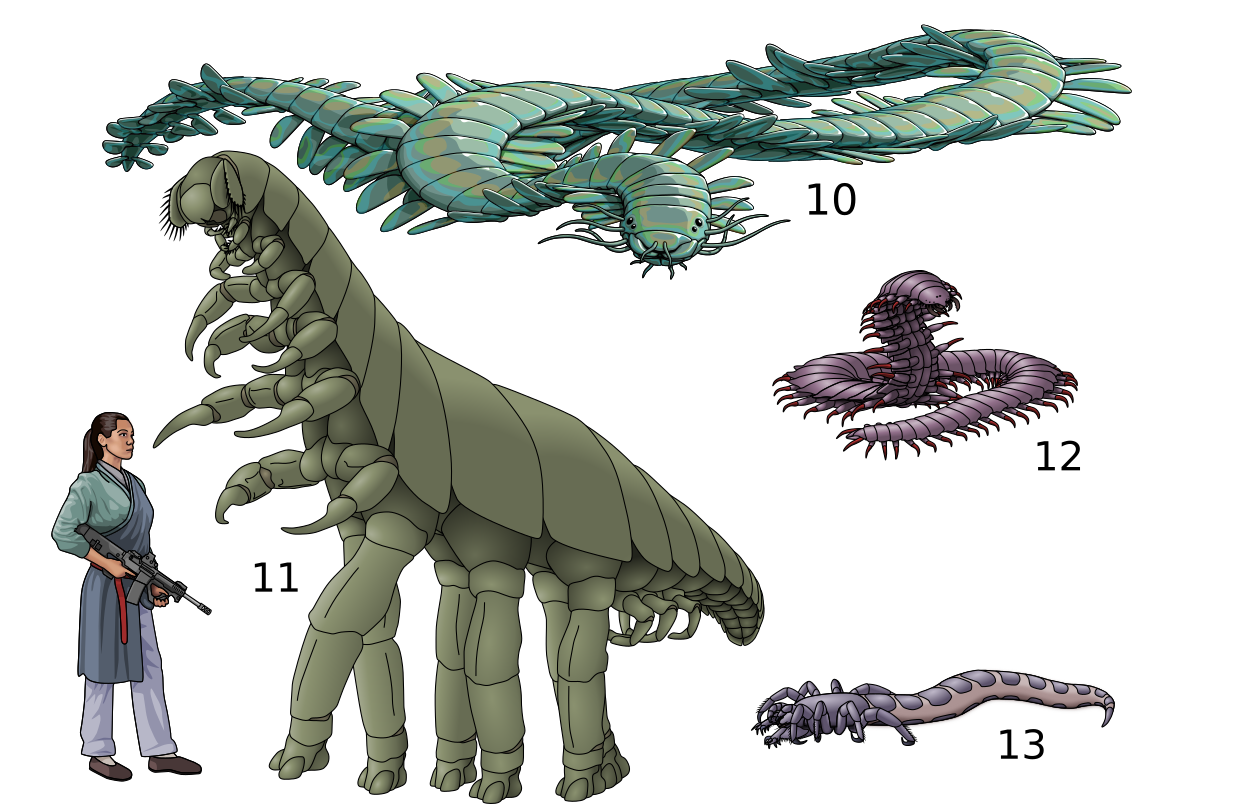|


- Death Roach: A fast-running, pack hunting carnivore that chases down its prey and rips them to shreds with its pincers.
Death roach packs are led by the females, which are larger and stronger than the males.
They have a complicated power structure, with internal clans and shifting alliances competing for dominant positions.
The females have one young at a time, which are born into the status of their mother.
- Fènghuáng: Named after the legendary bird of virtue, the fènghuáng is a variety of flying xiè. Fènghuáng are four-winged powered fliers, soaring the thermals on their diaphanous wings. They are hunter-scavengers, snatching up small animals with their clawed raptorial limbs or descending on carcases to feast on the festering flesh. Larger varieties have been known to attack Humans on steep mountain trails, throwing them over the edge of the precipice before flying down to claim their prize.
Fènghuáng pair up to nest; some species remain in the same pairs for life, although this is not universal. Fènghuáng nests are built in trees, cliffs, or islands inaccessible from the mainland. The female broods over the eggs while the male supplies her with food. Both members of the pair will defend their nest with great ferocity.
Once hatched, the young can fly immediately and leave their nest and parents to strike out on their own.
- Roll-Up Xiè: An omnivore, mostly feeding on detritus, fallen fruit, roots, low growing stems, leaves, and shoots, and small animals in its path. As their name indicates, roll-up xiès can roll up into an armored ball if threatened.
Roll-ups may be solitary, particularly bachelor males, but this depends on the species. Many move around in groups ranging from families to troops numbering in the several dozens. Roll-up groups have a habit of moving single file, nearly head-to-tail, with the largest up front. These lines of armored xiè are a common sight where they are not hunted to excess.
- Mantis Xiè: Mantis xiè are creeping ambush predators that lunge out to grab prey with their spiked raptorial appendages.
Each will claim and defend a suitable hunting territory.
A male's territory may overlap with that of several females. Male mantis xiè grow larger than females, so that they favor different prey and don't compete for the same resources.
A female will attend a brood of dozens of eggs or young; caring for, cleaning, defending, and feeding them until their second moult at which point they disperse.
- Box Xiè: This critter will withdraw its legs and face into its shell when threatened and close off the opening with its head shield. Unfortunately, many species are so big that they don't feel threatened by Humans (or similar-sized sapients). They may be grazers and low browsers, but these are no gentle giants. Much like bison, cape buffalo, elephants, hippos, or rhinos, they can be very cranky. The critter's dietary habits are not much consolation when you are being crushed and stomped by a one-ton alien crab-monster.
Box xiè live in herds. Those of forest species are often small, while plains-dwellers travel in vast swarms that number in the thousands. Females follow the lead of their most experienced members, moving together with their immature offspring. Males separate into bachelor herds for most of the year, testing their strength against each other by head slamming into each other. During the rut, this behavior intensifies and the males are likely to attack anything that isn't obviously a predatory threat. The most dominant males earn the right to a group of females and father the next generation.
- Hook Xiè: This is a high browsing herbivore, using a grab-and-pull method of dragging branches down to its mouth to be stripped and macerated - similar to gorillas, chalicotheres, ground sloths, and therizinosaurs. The branch hooks also double as defensive weapons. Combat between cantankerous males looking for breeding rights usually involves chest bashing and pushing rather than strikes with their much more lethal hooks. Humans are not afforded the same courtesy. Getting between a mother hook xiè and her brood is not recommended.
Hook xiè live in family groups consisting of a dominant male, several females in his harem, and immature young. When the hooklings mature, they set out on their own. Females can usually quickly find a new group to settle into. Unattached males will hang out in bachelor herds until they are able to acquire a harem of their own.
- Ostrich Xiè: A coursing predator that grabs you with its claws, restrains you with its meat-hook claspers, and then chews you to death with its scissor mouth parts.
Ostrich xiè usually live in prides consisting of one to three related adult males, several females, and any immature offspring.
The males vigorously defend their pride from any threat, including other males.
Males are larger, stronger, and slower than females; males tend to hunt larger, stronger prey from cover while the females hunt smaller faster prey over open ground. Nonetheless, even females use cover and stealth as much as possible when sneaking up on their victims. They coordinate their assaults, flushing prey towards waiting pack-mates. Commonly females will herd prey toward the cover where the males are lying in ambush.
- Xióng Xiè: A large omnivore. The majority of the diet of the xióng xiè is made up of shoots, roots, and fruits, but it greedly gobbles up any animals it can find, catch, and overpower. These animals are notoriously hungry and cranky, and likely to attack if surprised. During the breeding season, males become exceptionally cranky and roam widely looking for mates. Females may be trailed by up to a dozen young, females with young are also likely to be extremely protective of their brood.
Xióng xiè entering villages to raid garbage cans are a major nuissance.
- Hóu Xiè: Arboreal, brachiating omnivores. Hóu xiè travel in groups ranging from half a dozen to several dozen. In most species, the band is led by the females, with males moving out of their natal group upon reaching maturity. They move quickly through trees by hooking branches with their long limbs and swinging from branch to branch. Hóu xiè keep in contact in the tree canopies with piercing whistles. They mainly eat leaves, shoots, fruit, flowers, and nectar, but will also catch and eat small animals when the opportunity arises.
- Rainbow Lóng: An aquatic river predator, named for its iridescent cuticle and similarity in shape and habitat to the weather and water deities of old China. While its rainbow iridescence is striking out of the water, when submerged it is difficult to see. This lets it ambush large animals that come to the shore to drink. Despite this, its main diet is fully aquatic swimming organisms – the equivalent of earth's fish.
Rainbow Lóng often gather in large groups. It was originally through that these were mere accumulations of convenience, without any real social structure other than strength-enforced dominance. Emerging evidence is that they are more social and cooperative than thought – herding schools of prey towards others waiting in ambush, or working together to bring down or dismember large prey. Footage of a lóng exploding from the water to latch on to a box xiè's head, preventing it from closing up, giving the opportunity for others to swarm its vulnerable neck and chew through its head-closing muscles, are typical of this new thinking.
In the breeding season, the deep, hollow booming calls of the great bulls can be heard for kilometers as they stake out the best locations in their rivers and lakes and call for mates.
- Tree Knocker: One of Zhǎngshān's largest animals, the tree knocker is an immense herbivore. Using its long neck to reach high into trees for browsing or to sweep a wide area of ground for grazing, the tree knocker gets its English name from its habit of tearing up, breaking, or knocking over trees to devour their crowns which would otherwise be out of reach. Tree knockers can be quite cranky, especially males in rut or females carrying their brood of hundreds of knocklings under their tail. Humans earning their wrath may be trampled, gored with the neck grippers, or smashed with a blow of a swung neck. The battles between two titanic bull knockers make the ground tremble as they shove and grapple with their neck grippers, or bludgeon each other with their necks, to determine who is the strongest and therefore gets the right to mate the females.
Tree knockers roam the plains, scrub, and woodlands in large mixed herds. Outside of the mating season, they seem largely unstructured. The herds migrate immense distances, follwoing the cycle of rains and seasons and monsoons to lands withe enough forage to support their immense bulk.
During the rut, the most dominant bulls gather harems of around one to two dozen cows which they defend from all challengers.
Knocklings are carried under their mother's tails until their first molt, at which time they strike out on their own. The small knockers stay in cover while they build up their bulk for several seasons, until they are large enough to join a herd.
- Carpet Chóng: A solitary ambush predator preferring areas of thick vegetation, carpet chóng strike and grab their prey with their six pincer-mandibles quickly followed by wrapping their victim with their flexible body to restrain it, impaling it with their meat-hook legs in the process. The carpet chóng then begins to eat its victim, often while it is still alive.
Carpet chóng rarely associate with each other. They have home ranges and know all of the best hunting spots, but do not defend territories. Females lay clutches of eggs in a suitable nest, and then abandon them.
- Leg Biter: A burrowing predator. It digs up other burrowing animals, or chases them down into their holes to kill them in their homes. More problematic for people, however, is when it hunts in ambush. It will dig up nearly to the surface, or cover the entrance to its lair with a layer of vegetation to camouflage it, and wait for the vibrations of something edible-sized walking nearby. Then it erupts out and grabs its quarry, injecting a necrotic venom from its pincer-fangs that liquefies the insides of its victim. A person trodding near one of these ambush sites will trigger an attack, and where leg biters are common many farmers and outdoor laborers suffer maimed or missing legs or feet.
It is thought that the leg biter venom also contains potent systemic toxins as well - but they are optimized for disabling and killing Zhǎngshānese biology rather than Terran. A human-sized xiè or chóng would probably be dead from a leg biter envenomation within half an hour.
Leg biters are solitary hunters. They come together only to breed. In the mating season, males come out of the ground and wander widely, looking for mates. Females lay their eggs in a well hiden nest, and then leave. The young look after themselves from the moment they hatch.
Back to Zhǎngshān.
Back to Vergeworlds Main Page
|